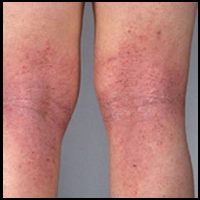Eczema is represents several types of skin inflammation disease. The disease is also referred as dermatitis and the most common form the disease is atopic dermatitis. However, it is very also very common to find other forms of eczema. The disease mostly affects the infants but in some cases it can be also found in adults. In infants the disease gets healed automatically when they reach the age of may be 3 or 4 years but in adults it can reoccur throughout their life. It a hereditary disease and in one family more than one person can be the victim of eczema. However, although it is a skin disease but it is not transmitted from one person to other.

Eczema affect more to females as compared to male and the disease can be seen in people around the world. The acuteness of the disease can be accelerated while the patients come in contact with soaps, cosmetics, clothing, detergents, jewelry, or sweat. Further, in many cases it can be also found the patients are also allergic to sun light, humidity, sudden change in weather, dust, pollution, and many other things. The disease brings rashes and scales on the skin of the patients, which often very itchy and cause inflammation. The disease mostly affects the face, neck elbow, waist, under arms, and other areas of human body. In infants it is more prominent on forehead, cheeks, neck and on back areas. Eczema in any form cause severe itching at the affected area.
Among the several treatments homeopathy treatment proves to be for eczema. Vira’s Homeopathy Clinic specializes in providing complete treatment for eczema. Our doctor’s are high experienced and well equipped with advanced medicines for providing best treatment for the disease and for better results. Thus, you can trust us for permanent treatment for the disease.
Atopic dermatitis is a chronic skin disease characterized by itchy, inflamed skin and is the most common cause of eczema. The condition tends to come and go, depending upon exposures to triggers or causative factors. Factors that may cause atopic dermatitis (allergens) include environmental factors like molds, pollen, or pollutants; contact irritants like soaps, detergents, nickel (in jewelry), or perfumes; food allergies; or other allergies. Around two-thirds of those who develop the condition do so prior to 1 year of age. When the disease starts in infancy, it is sometimes termed infantile eczema. Atopic dermatitis tends to run in families, and people who develop the condition often have a family history of other allergic conditions such as asthma or hay fever.
Contact eczema (contact dermatitis) is a localized reaction that includes redness, itching, and burning in areas where the skin has come into contact with an allergen (an allergy-causing substance to which an individual is sensitized) or with a general irritant such as an acid, a cleaning agent, or other chemical. Other examples of contact eczema include reactions to laundry detergents, soaps, nickel (present in jewelry), cosmetics, fabrics, clothing, and perfume. Due to the vast number of substances with which individuals have contact, it can be difficult to determine the trigger for contact dermatitis. The condition is sometimes referred to as allergic contact eczema (allergic contact dermatitis) if the trigger is an allergen and irritant contact eczema (irritant contact dermatitis) if the trigger is an irritant. Skin reactions to poison ivy and poison sumac are examples of allergic contact eczema. People who have a history of allergies have an increased risk for developing contact eczema.
.
Seborrheic eczema (seborrheic dermatitis) is a form of skin inflammation of unknown cause. The signs and symptoms of seborrheic eczema include yellowish, oily, scaly patches of skin on the scalp, face, and occasionally other parts of the body. Dandruff and “cradle cap” in infants are examples of seborrheic eczema. It is commonplace for seborrheic dermatitis to inflame the face at the creases of the cheeks and/or the nasal folds. Seborrheic dermatitis is not necessarily associated with itching. This condition tends to run in families. Emotional stress, oily skin, infrequent shampooing, and weather conditions may all increase a person’s risk of developing seborrheic eczema. One type of seborrheic eczema is also common in people with AIDS.
Nummular eczema (nummular dermatitis) is characterized by coin-shaped patches of irritated skin — most commonly located on the arms, back, buttocks, and lower legs — that may be crusted, scaling, and extremely itchy. This form of eczema is relatively uncommon and occurs most frequently in elderly men. Nummular eczema is usually a chronic condition. Neurodermatitis
This form of eczema results in scaly patches of skin on the head, lower legs, wrists, or forearms. Over time, the skin can become thickened and leathery. Stress can exacerbate the symptoms of neurodermatitis.
Stasis dermatitis is a skin irritation on the lower legs, generally related to the circulatory problem known as venous insufficiency, in which the function of the valves within the veins has been compromised. Stasis dermatitis occurs almost exclusively in middle-aged and elderly people, with approximately 6%-7% of the population over 50 years of age being affected by the condition. The risk of developing stasis dermatitis increases with advancing age.
Dyshidrotic eczema (dyshidrotic dermatitis) is an irritation of the skin on the palms of hands and soles of the feet characterized by clear, deep blisters that itch and burn.

